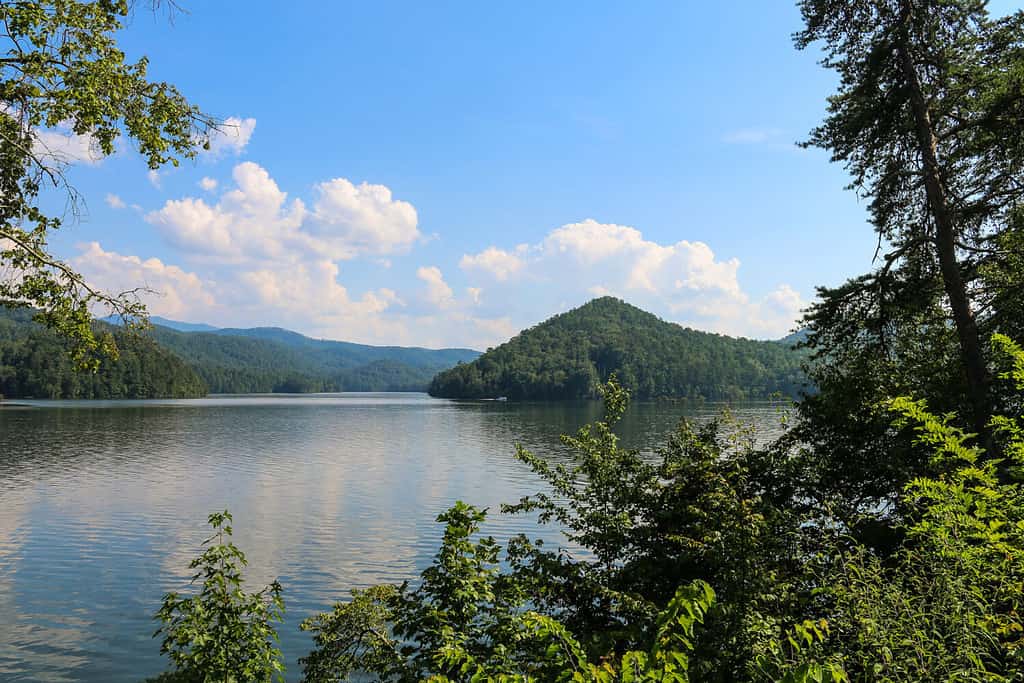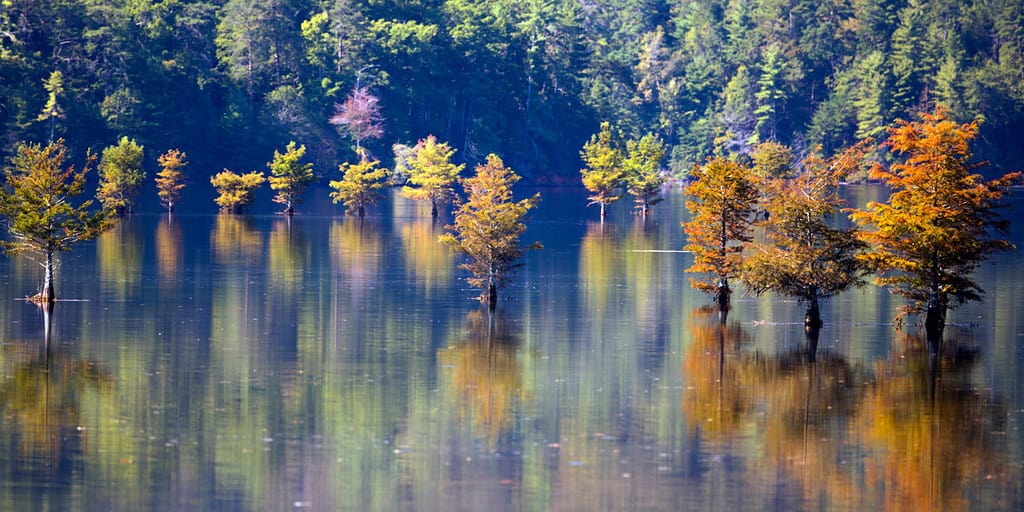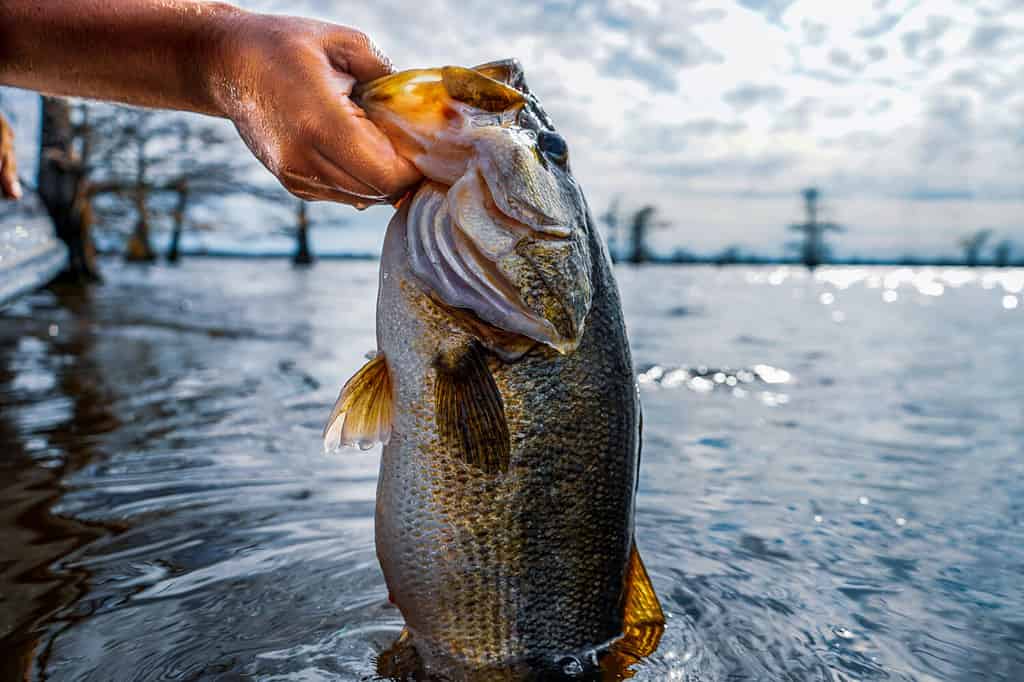Discover the Oldest Man-Made Lake in Tennessee

The oldest artificial lake in Tennessee is Lake Ocoee or Parksville Lake. Lake Ocoee lives in the Cherokee National Forest and has been around since 1911.
The Tennessee Valley Authority (TVA) bought the dam in 1939 and now controls the area.
Ocoee Lake is 1,930 acres and is perfect for recreation.
The Tennessee Rural Electric Company began creating Ocoee Lake in 1910 and 1911. They built the Parksville Dam, which, in turn, created the lake. The dam was one of the region’s first hydroelectric projects.
The dam is an astonishing 840 feet long and 135 feet high. The lake can hold 19,000 acre-feet of water in case of a flood. The water levels fluctuate as much as 9 feet from summer to winter.
The Ocoee River — which makes up the Ocoee Lake — begins in Georgia as the Toccoa River. It travels through western North Carolina to east Tennessee for about 93 miles. It eventually joins the Hiwassee River just above Benton, TN.
How to get to Lake Ocoee

Lake Ocoee is a beautiful area for boating, fishing, and hiking.
©Christopher P/Shutterstock.com
The closest town to Lake Ocoee is Benton, which is only about 10 minutes away.
Reach Lake Ocoee by traveling the Ocoee Scenic Byway.
Take route US 64 if you’re looking to launch a boat into the lake, as there are a few boat ramps along that route. Keep in mind that it costs $3 per vehicle per day to use the boat ramps.
Route 64 follows the lake’s shoreline for about 5 to 6 miles. The road is perfect for a scenic drive, even if you don’t plan on boating.
East Parksville Boat Launch
Use the East Parksville Boat Launch if you want to explore the northern part of the lake. This ramp is the largest of the lake’s ramps, so it’s ideal for bigger vessels. There is a vault toilet available and a dock for fishing.
Reach the East Parksville Boat Launch by traveling down Route 64. Turn left onto the highway from the Ocoee Ranger Station. The boat ramp will be about 1.1 miles down the road to the right.
Parksville Boat Launch
A tad further away is the Parksville Boat Launch, which you can use to access the northeastern part of the lake.
This area hosts two boat launches. One is ideal for larger vessels and better for small ships like kayaks, canoes, and jet skis.
Plenty of parking is available at this boat launch, and a vault toilet is on-site for your comfort.
Drive down Route 64 to reach the Parksville Boat Launch. Turn left onto the road from the Ocoee Ranger Station. The boat ramp is about 0.9 miles down the highway to the right.
King’s Slough Boat Launch
The King’s Slough Boat Launch is ideal for those wanting to boat in the western part of the lake. Remember that this boat ramp is exceptionally shallow, so it may not be suitable for larger vessels.
Like the other boat launches, the King’s Slough Boat Launch has plenty of parking and vault toilets for your convenience.
Reach the King’s Slough Boat Launch by traveling down Route 64 after turning right from the Ocoee Ranger Station.
You’ll have to drive about 4.8 miles and turn left onto Cookson Creek Road. Then, drive another 3.4 miles before turning left onto the Forest Service Road 55A. Next, drive about 0.4 miles until you reach the ramp to the right.
How Healthy is the Ocoee Lake?
According to the Tennessee Valley Authority (TVA), Lake Ocoee has a “fair” health rating. Officials look at the following five factors to determine the health of the lake:
- Dissolved oxygen levels
- Chlorophyll levels
- Sediment quality
- Benthic macroinvertebrate community (the animals that live at the bottom of the lake)
- Fish assemblage
The TVA last assessed the lake’s health in 2017 when it was “fair.” The lake’s health was “good” between 2009 and 2014.
Its health levels dropped because of the chlorophyll and dissolved oxygen readings.
What is the Current Condition of Lake Ocoee
The nearby copper mines and deforestation have significantly changed the Lake Ocoee area.
More fish that don’t belong there live in the lake, including Alabama bass, blueback herring, and hydrilla. These species are non-native and invasive, creating competition for the native species in the lake.
The lake has also significantly increased aquatic vegetation over the last ten years.
How to Have Fun at Lake Ocoee

Lake Ocoee sometimes floods, causing shorter trees to be partially covered.
©Paul Oppenheim/Shutterstock.com
The lake is top-rated for boating. The water covers a large expanse, and the scenery is beautiful.
You can picnic at Parksville Beach or Mac Point and enjoy the elegant forests and rolling hills. Mac Point and Parksville Beach are also popular swimming spots. Or, take a long hike on one of the trails at the Chilhowee Recreation Area.
The Parksville Campground is only a few minutes away.
Head to Sugarloaf Park below the dam for another lovely picnic spot.
Ocoee River is One of the Best Places in the Country for Whitewater Sports
There are three dams along the Ocoee River, with the Parksville Dam being the first.
The Ocoee River is among the nation’s top 10 places for whitewater sports. The Ocoee River was used in the 1996 Olympics.
The U.S. Forest Service began creating the Olympic whitewater rafting course in 1993. You can now see the course model in Sugarloaf Park below Ocoee Lake.
The Ocoee River has class three and four rapids. Thrill-seekers can test themselves on these rapids from April until October.
Recreational whitewater rafters can travel down the River. Several outfitters supply rentals and conduct whitewater tours.
The River is gentler around Ocoee Lake, where the rapids are only Class I.
For more adventure, you’ll have to go to the upper and middle portions of the River. The Olympic whitewater course is about 1 mile long in Ducktown, TN. You should begin below Ocoee Dam No.2 for more Class III or IV rapids.
Be Careful when Having Fun on the Lake
Remember that the lake sits on an operating dam, which can be dangerous if you’re not paying attention.
Always check the dam release schedule before heading onto the water. The schedule can change quickly, so check it shortly before your adventure.
Sometimes, the dam may release water without any notice. Unscheduled releases often occur if there is an increased need for electricity. The turbines turn on automatically with no warning.
The sudden release of water can be dangerous to even the largest vessels and skilled boaters. Currents can pull boats and shred them to pieces.
How to be Safe on the Ocoee Lake or River
The Tennessee Valley Authority (TVA) oversees the Ocoee River dams. They have measures to keep visitors safe.
The TVA has implemented the following measures to prevent devastation:
- There are warning signs around the area, indicating the most dangerous areas. They warn visitors that the area is known for quickly rising water and that they should stay away.
- The TVA blows loud horns before they release water from the dam. Lake and river visitors should exit the water and get to safety immediately.
- Like horns, strobe lights indicate the plant will begin creating electricity. If you see the strobe lights, leave the lake or River immediately and get to safety.
The Best Time of Year to Fish in Lake Ocoee

Largemouth bass are one of the most common fish in Lake Ocoee.
©Maclane Parker/Shutterstock.com
The government stocks Lake Ocoee with black crappie, bluegill, muskie, redear sunfish, trout, and walleye. Other fish in the lake include bass, catfish, and yellow perch.
The best time and place to catch fish in Lake Ocoee depends on the species. Take a look at the table below for a guide.
| Fish | Best Place to Catch | Best Time to Catch |
|---|---|---|
| Largemouth Bass | The upper end of Lake Ocoee | Early Spring — shallow areas Late Spring to Early Summer — deeper water Fall — creeks with “high bait presence” Winter — steep banks |
| Alabama Bass | The lower end of Lake Ocoee | Early Spring — steep rock banks Late Spring — creeks and sloping banks Fall — shallow water Winter — steep banks |
| Crappie | Anywhere in Lake Ocoee — nearby Chickamauga Reservoir is better | Spring — shallow creeks and coves Summer — deeper water Fall — shallow areas around brush and laydowns Winter — deeper water |
| Redear Sunfish | Anywhere in Lake Ocoee | Spring — shallow creeks and coves Summer — shallow water close to deep water areas Fall — Deep water of 10-15 feet near rocky banks Winter — Deep water of 10-15 feet near rocky banks |
| Bluegill | Anywhere in Lake Ocoee | Spring — shallow creeks and coves Summer — shallow water close to deep water areas Fall — Deep water of 10-15 feet near rocky banks Winter — Deep water of 10-15 feet near rocky banks |
| Yellow Perch | The upper end of Lake Ocoee near Greasy Creek | Anytime — Search the bottom of the creek |
| Walleye | Along the Main River Channel Try upstream of Ocoee Lake during the spawning season from February through April | Anytime |
| Muskie | Anywhere — The upper end of Lake Ocoee and Sylco Creek are the best | Early Spring, Fall, and Winter, when the water temperatures are cooler |
The Tennessee Wildlife Resources Agency provides a more extensive guide for catching each fish.
You can even download the Fishbrain—Fishing App to see real-time fishing forecasts for each species in Lake Ocoee.
Anglers Love Lake Ocoee
According to anglers who frequent Lake Ocoee, spotted bass are the most abundant and easiest-to-catch fish. Bluegills and largemouth bass are close behind.
Local anglers reportedly love coming to Lake Ocoee. Some say the fish in the lake are significant and are willing to eat anything, making them easy pickings.
Are There Any Fishing Regulations or Restrictions?
Lake Ocoee and the surrounding River are beautiful areas for fishing, but there are some regulations.
For example, you can only catch five largemouth and smallmouth bass a day, and they have a size limit. Largemouth bass must be at least 15 inches long, while smallmouth bass must be 18 inches long.
As another example, crappies must be at least 10 inches long if you want to keep them. Plus, you can only hold 15 crappies a day, regardless of species.
Check the Tennessee Wildlife Resources Agency website for all rules and regulations. The website also explains the best places to catch each kind of fish.
The photo featured at the top of this post is © Christopher P/Shutterstock.com
Thank you for reading! Have some feedback for us? Contact the AZ Animals editorial team.







